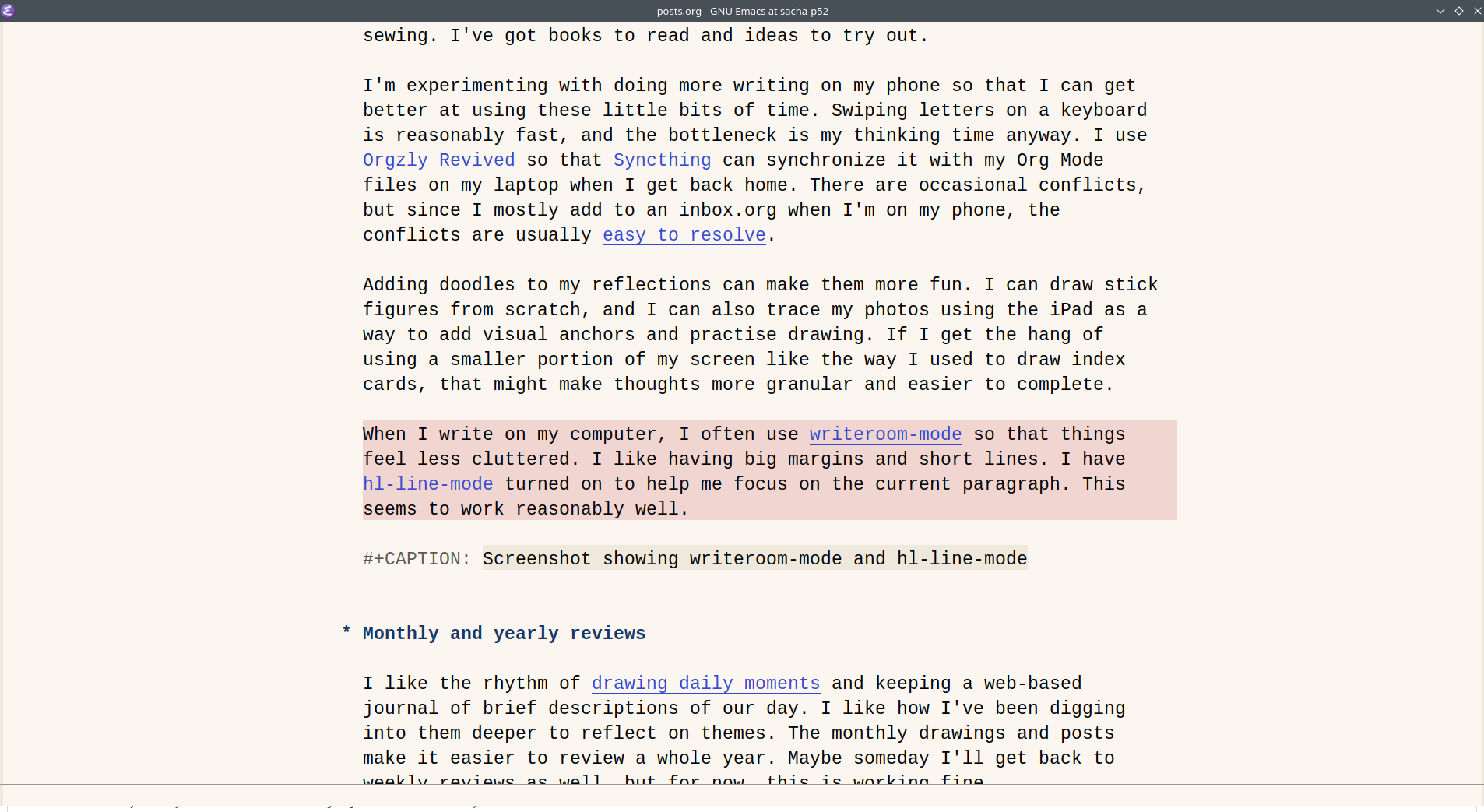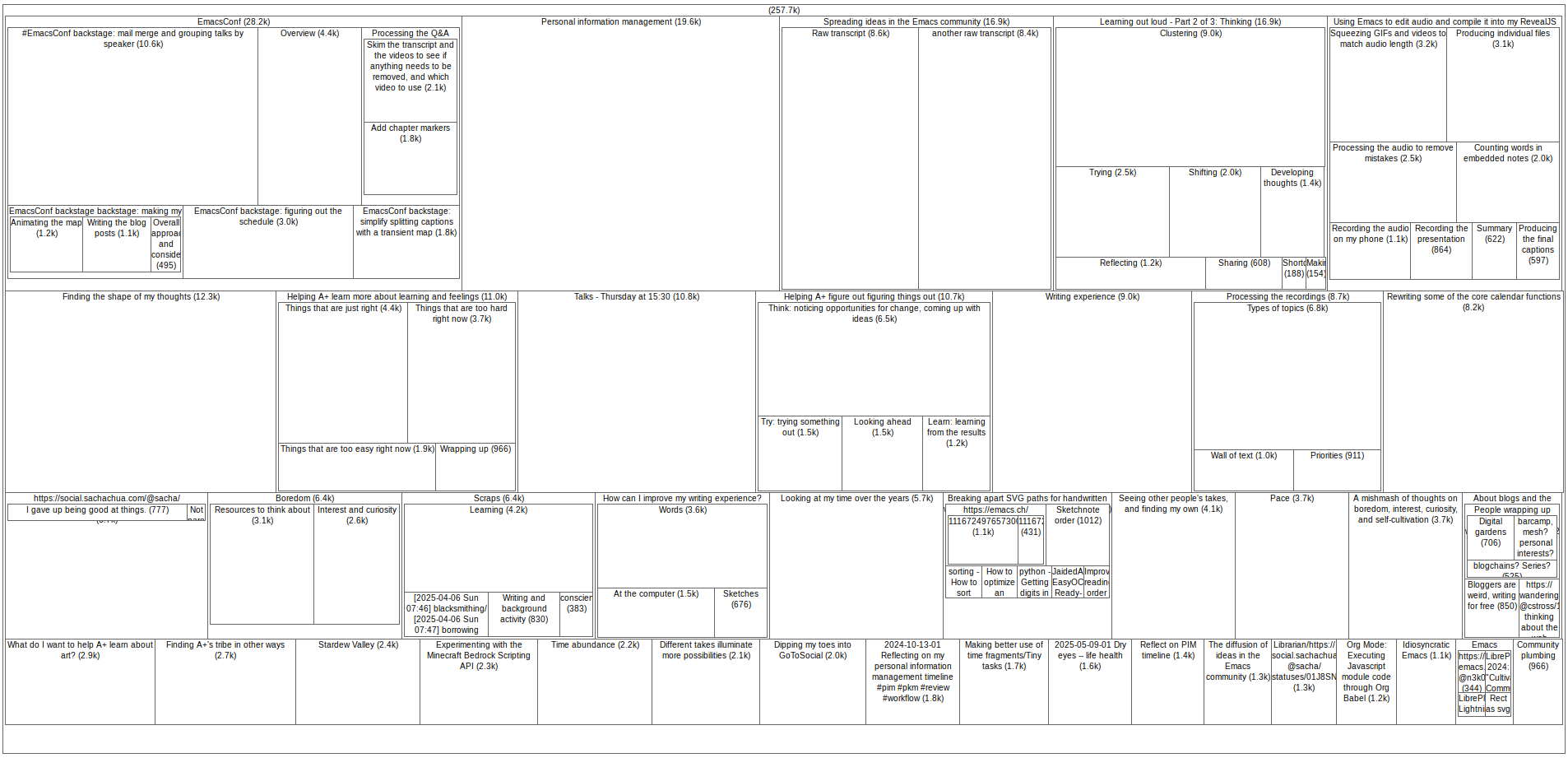2025-08-25 Emacs news
| emacs, emacs-newsI'm experimenting with commentary and formatting! =) The Emacs Carnival blogging theme of elevator pitch seems to have resonated with a lot of people: 18 entries so far, which is perfect timing because there's also a new online book for Emacs beginners. Also, if you're looking for a "Can your text editor do this?!" sort of example, there was a lively discussion about clipping videos with Emacs on Hacker News. (Be prepared for bewilderment, though.) On the other hand, if you're here for serious stuff and want a technical deep dive, check out Yuan Fu's post on Emacs tree-sitter integration. Here are the other links:
- Help wanted:
- Upcoming events (iCal file, Org):
- Emacs Berlin (hybrid, in English) https://emacs-berlin.org/ Wed Aug 27 0930 America/Vancouver - 1130 America/Chicago - 1230 America/Toronto - 1630 Etc/GMT - 1830 Europe/Berlin - 2200 Asia/Kolkata – Thu Aug 28 0030 Asia/Singapore
- Emacs Paris: S: Emacs workshop in Paris (online) https://emacs-doctor.com/ Tue Sep 2 0830 America/Vancouver - 1030 America/Chicago - 1130 America/Toronto - 1530 Etc/GMT - 1730 Europe/Berlin - 2100 Asia/Kolkata - 2330 Asia/Singapore
- EmacsATX: Emacs Social https://www.meetup.com/emacsatx/events/310417272/ Thu Sep 4 1600 America/Vancouver - 1800 America/Chicago - 1900 America/Toronto - 2300 Etc/GMT – Fri Sep 5 0100 Europe/Berlin - 0430 Asia/Kolkata - 0700 Asia/Singapore
- M-x Research: TBA https://m-x-research.github.io/ Fri Sep 5 0800 America/Vancouver - 1000 America/Chicago - 1100 America/Toronto - 1500 Etc/GMT - 1700 Europe/Berlin - 2030 Asia/Kolkata - 2300 Asia/Singapore
- Beginner:
- Emacs configuration:
- standard-keys-mode: A minor mode for emulate "modern" and common keybindings from modern editors (Reddit)
- `OpenEmacs`, humanized and intuitive, simple Emacs configuration, guides users to use Emacs immediately. (Reddit)
- Yi Tang: Multiple Working Emacs
- [OC] package-retry.el - Automatic retry for failed package installations (Reddit)
- Emacs Lisp:
- Appearance:
- Navigation:
- Jakub Nowak: Make Neotree "Tab-Local"
- Quickly navigate in man pages, using emacs, neovim or w3m. (Reddit) - g for subsection, r to follow link
- Org Mode:
- Stop renting your life - own it - Org Mode and tasks
- TIL: Org Mode Can Sort Lists Automatically! C-c ^ (org-sort)
- Randy Ridenour: Creating Attendance Sheets with Org Mode
- Marcin Borkowski: Counting Org mode headlines
- Screenshots into emacs org files in Windows | Mark's Project Blog (@mark@mastodon.fixermark.com)
- Completion:
- Coding:
- Math:
- Web:
- Multimedia:
- Marcin Borkowski: 2025-08-18 Cutting clips from videos with Emacs (Hackaday)
- Alvaro Ramirez: Emacs as your video-trimming tool (170 comments on HN including this humorous one-upping, lobste.rs, Reddit, Irreal, Github)
- Fun:
- My other email client is a daemon (Reddit) - mu4e and nethack-el
- Listful Andrew: llamascii art
- Mail Amusements (GNU Emacs Manual) (HN)
- AI:
- Community:
- New: search.emacslife.com (Announcement)
- Eric MacAdie: 2025-08 Austin Emacs Meetup
- Emacs Tip Jar: Weekly Prize Fund for People Who Do Good Emacs (Reddit)
- Elevator pitches:
- M-x apropos Emacs: Elevator pitch (@oantolin@mathstodon.xyz)
- Emacs – The Editor of the Revolution (@realCheGnuevara@mastodon.social)
- Charles Choi: Emacs Elevator Pitch (Reddit, Irreal)
- Jeremy Friesen: Elevator Pitches for Emacs (Irreal)
- Ross A. Baker: Emacs Elevator Pitch
- bare metal (the emacs essay) | wax banks
- Emacs is violent passion (Reddit, lobste.rs)
- My Elevator Pitch for Emacs
- emacs elevator pitch
- Emacs carnival: Elevator pitch (or How I learned to love RSS for the fediverse) (Irreal)
- Emacs as an alternative computing paradigm
- Adventures with Emacs - high12noon blog
- Elevator pitch for Emacs (Discurso de ascensor para Emacs)
- Interviews:
- Other:
- Tip about using rectangular selection to copy columns from ASCII tables
- rtrppl/emacs-trans: Emacs wrapper for translate-shell. (@laotang@mastodon.social)
- pivaldi/emacs-passfile: Very simple Emacs package allowing to view and edit securely a GnuPG encrypted file (@_PI_@fosstodon.org)
- Termux APK signed for Android Emacs, works on Android 15 (Reddit)
- Emacs development:
- Feedback Directed Optimization of Emacs With Clang For Great Justice (Reddit)
- emacs-devel:
- Should we add a section about "Semantic Linefeed Filling" to the Emacs user manual?
- Dmitry and Spencer volunteering to help with threads, yay
- More Nextstep details Re: Emacs-mac as an alternative to NS
- Copyleft considerations re: LLVM and MacOS
- use-package: Discussion of potential :hook-after/:hook-add/:hook* keyword
- Merge remote-tracking branch 'savannah/master' into master-android-1
- * etc/NEWS: Mention 'lua-mode' merge.
- Disallow string data resizing (bug#79784)
- Have project-switch-to-buffer use a distinct completion category
- Add NEWS entry for project-switch-buffer change from bug#77312
- Use better temporary file names under 'file-precious-flag'
- flymake: stop trying to automatically fall back to margins
- project: Improve pruning of zombie projects.
- Speed up JSON parsing by not maintaining line and column (bug#79192)
- Rename some incoming & outgoing diff commands
- New packages:
- bracket-face: A face for brackets (MELPA)
- cond-let: Additional and improved binding conditionals (MELPA)
- electric-list-directory: Lightweight popup directory browser (MELPA)
- eprolog: Native Prolog engine implementation (MELPA)
- lobsters: A Lobsters client (MELPA)
- ol-bible: Org Link support for Bible Passages (MELPA)
- org-srs: A flexible spaced repetition system for Org-mode (MELPA)
- parenthesis-face: A face for parentheses (MELPA)
- project-cmake: A cmake backend for project.el (MELPA)
- rcirc-mentions: Log mentions of your nick or keywords in a separate buffer (GNU ELPA)
Links from reddit.com/r/emacs, r/orgmode, r/spacemacs, r/planetemacs, Mastodon #emacs, Bluesky #emacs, Hacker News, lobste.rs, programming.dev, lemmy.world, lemmy.ml, planet.emacslife.com, YouTube, the Emacs NEWS file, Emacs Calendar, and emacs-devel. Thanks to Andrés Ramírez for emacs-devel links. Do you have an Emacs-related link or announcement? Please e-mail me at sacha@sachachua.com. Thank you!





